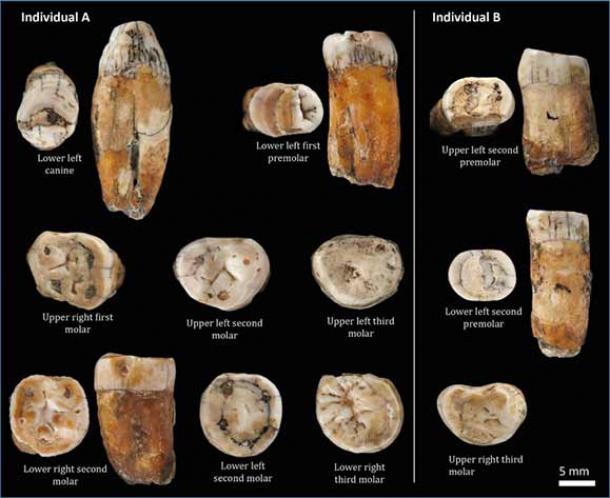Modern technology has allowed experts to re-analyze ancient Neanderthal teeth discovered at the start of the 20th century in a Jersey cave. They have been found to share attributes with those of modern humans, which could mean that there was more interbreeding between Neanderthals and modern humans than we previously thought.
The 2010 publication of the Neanderthal draft genome sequence revealed that “about 2 percent of the DNA in the genomes of modern-day people with Eurasian ancestry “is Neanderthal in origin.” It has long been known that Neanderthals left their genetic mark in the DNA of modern humans. However, in September 2020 I covered a recent Science report by evolutionary geneticists Martin Petr and Janet Kelso in an Ancient Origins article. This work showed how Homo sapiens’ DNA imprinted onto Neanderthal populations when the two species met in Eurasia around 45,000 years ago.
Now, re-analysis of thirteen “48,000-year-old Neanderthal teeth” originally discovered in Jersey between 1910 and 1911 has revealed that while they have always been assumed to have come from a single Neanderthal, they actually came from at least two individuals. Furthermore, the thirteen Neanderthal teeth from both individuals “share traits that are distinctive of modern humans .” In short, this means Neanderthals and Homo sapiens had a “shared ancestry.”

A selection of the Neanderthal teeth discovered at La Cotte de St. Brelade on Jersey. ( Trustees of the Natural History Museum )
Genetic Signatures of Ancient Interbreeding in Neanderthal Teeth
The collection of thirteen deeply-ancient Neanderthal teeth were first uncovered within the La Cotte de St Brelade cave in Jersey by archaeologists with the Société Jersiaise between 1910 and 11. The earliest excavations in the cave recovered more than 20,000 stone tools of a Middle Paleolithic design that were all associated with Neanderthals living there between around 250,000 and 48,000 years ago. This site is the earliest known occupation of the Channel Islands by a hominin species. It also represents one of the last Neanderthal sites in northwestern Europe before the species died out.
The new paper published in the Journal of Human Evolution presents a re-analysis of thirteen teeth likely dating back to 48,000 years ago, which is around 8,000 years before Neanderthals went extinct. This date was derived from a fragment of occipital bone that was found in a separate locality in a later season, that radio-carbon dated to “a probable age of <48 ka.” Among the key findings presented in the new study is that the cervix, or the long-fluted neck of the tooth, “was shaped like those of humans.” What’s more, other features typical of Neanderthals, “like a transverse crest” were lacking. According to the researchers this means “interbreeding between Neanderthals and modern humans was common.”

The teeth were originally discovered in a cave on Jersey called La Cotte de St. Brelade. Also known as the Fairies’ Cave, this is a Paleolithic site in Saint Brélade. ( Public domain )
Bringing 48,000-Year-Old Gnashers to Your Mantle Piece
The lead author of the new paper, physical anthropologist Chris Stringer of the Natural History Museum , explained to BBC Science that the results from the new analysis of the La Cotte individuals teeth suggest they “could have had a dual Neanderthal–modern human ancestry.” Jersey Heritage curator, Olga Finch, said the La Cotte de St Brelade site is “of huge importance and it continues to reveal stories about our ancient predecessors.” In a Daily Mail article, archaeologist and dig leader Matt Pope, of the University College London , explains that “this work offers us a glimpse of a new and intriguing population of Neanderthal people and opens the door to a new phase of discovery at the site.”
While finds such as these are celebrated in academic circles, we, the readers, are left to imagine what Neanderthal-human teeth might have looked and felt like. But not this time. If any of you out there are collectors of the weird and wonderful, or teachers of the history, then you can download CT cross-section surface models and view them as high-resolution files, zooming in and out of cavities at the Human Fossil Record website . For the truly committed nerds among you, the 3D scans can be loaded into a 3D printer and the Neanderthal teeth can really be brought back to life. For the fanatics, as the scientists suggest, the 3D printed ancient teeth “ can be placed on your mantelpiece .”
Top image: The re-analysis of Neanderthal teeth found on Jersey at the start of the 20 th century appears to prove that Neanderthal interbreeding with modern humans was more common than previously thought. Source: Journal of Human Evolution
By Ashley Cowie
Related posts:
Views: 0
 RSS Feed
RSS Feed

















 February 3rd, 2021
February 3rd, 2021  Awake Goy
Awake Goy  Posted in
Posted in  Tags:
Tags: 
















